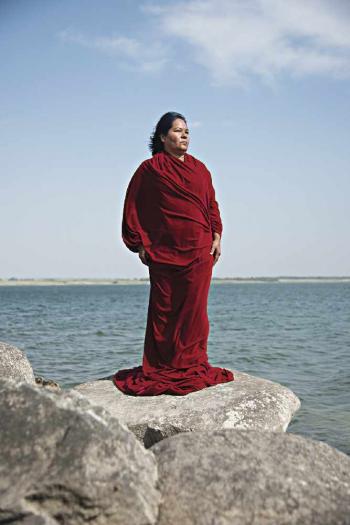Image Caption
Summary
By Andrea Smith
Windspeaker.com Contributor
TORONTO
The 2017 Scotiabank CONTACT Photography Festival carries a special message this year. It’s the year of Canada’s 150th birthday celebration, and the people behind CONTACT plan to focus on that.
The festival occurs all throughout the month of May, at galleries and museums around the Greater Toronto Area. The kickoff exhibitions are showcased in the Ryerson Image Center at Ryerson University during the start of the festival.
Using a theme of Canadian history, the exhibitions will contain works around changing landscape, projects that have made an impact, and people’s shifting perspectives over time.
Of course, Canadian history is not complete without an honest look at colonialism, so some of the displays also include works from Indigenous artists speaking truths about their own experiences and where they came from.
“We do Canadian and international photography… Our main goal is to celebrate artists in Canada and celebrate their career,” said Darcy Killeen, executive director of the CONTACT festival.
“This year, all the programming we’re doing… of the 200 exhibitions… is pretty much all Canadian. We’ve been the world’s largest for a long time and we’re trying to become one of the most prestigious,” he said.
“We started partnering with the Museum of Contemporary Art Toronto… that was our first large museum exhibition. Since then every cultural institution in the city is part of it… McMichael Museum, University of Toronto Art Museum, Power Plant, Harbour Front… Pretty much every museum in the city will have a CONTACT show,” said Killeen.
Bonnie Rubenstein is the artistic director for the festival. She had a say in just which exhibitions will go where. She chose three notable First Nations artist applicants to be part of the “primary” displays—meaning some of the biggest highlights in the year’s festival show—though she adds there are many other less advertised displays to be found throughout the city, also still a part of the CONTACT show.
“I was committed to finding really strong Indigenous artists that explored Indigenous issues in relation to it being Canada’s sesquicentennial… It always related but I felt this year it really needed to highlight issues that are pressing now,” said Rubenstein.
“The works are exceptional and they do drive issues home,” she said.
The primary displays by First Nations artists consist of work from Lori Blondeau—in the form of a piece called Asiniy Iskwew; Shelley Niro—in a piece called Battlefields of My Ancestors (April 28 to Aug. 13); and a collaborative creation presented by the National Film Board of Canada called Souvenier (April 29 to Aug. 13), which features art from Kent Monkman, Caroline Monnet, Jeff Barnaby, and Michelle Latimer.
There is also a “group exhibition” utilizing works by Indigenous artists being presented between two different venues—Trinity Square and Gallery 44— which runs from May 5 to June 3. This particular spectacle is called What does one do with such a clairvoyant image? And features the works of Dana Claxton, Stephanie Comilang, Kapwani Kiwanga, Dylan Miner, Martine Syms, and Tania Willard, and is curated by Leila Timmins, Cheyanne Turions and Jayne Wilkinson.
“Our aspirations are to continue to grow programming, and focus on more education to really make this festival a cultural destination for people around the world who come to Toronto… We have 1.2 million visitors to our festival every year,” said Rubenstein.
The name of Lori Blondeau's work is, Asiniy Iskwew, translates to “Rock Woman” in English. The title is suiting because her work is a series of images of her standing atop giant boulders considered part of sacred Indigenous sites. These photos are blown up to large poster sizes, and will be pasted to the boulders in the middle of Devonian Square at the Ryerson University campus. The exhibit begins April 28 and runs to Aug. 13
The piece, for Blondeau, represents that Canada’s Indigenous people—despite struggles—are still present. One of the sacred sites is the location of a boulder that was blown apart by the Saskatchewan provincial government to make way for a man-made lake in the 1960’s; While another is of smaller rocks at the University of British Columbia Okanagan campus. Both sites, and the accompanying images, hold powerful meaning for her, says Blondeau.
“I think that as Indigenous women, we’re still here… I don’t think it’s the best conditions for Indigenous women in Canada but it is what it is. It’s about pride. It’s about history,” she said.
“I just want people to be inspired by the images…I want them to look at them and maybe feel some kind of strength,” said Blondeau.
For more information visit http://scotiabankcontactphoto.com/

